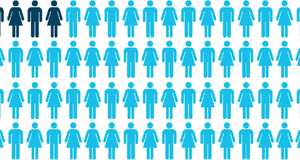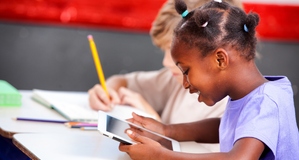Featured Article:The Implementation of Social Software in Authentic Literacy Activities
By
2014, Vol. 6 No. 11 | pg. 4/4 | « The Authentic Audience, Motivation, and Online SharingAn authentic or genuine audience is an essential component for authentic learning, especially when writing is involved (Carroll, 2013). “Authentic communicative contexts” (Barnitz, 1998, p. 608) and “learner produced texts” (p. 609) are essential components in authentic literacy activities. In traditional settings, the audience for these activities could be other students or through dialogue with the teacher. As indicated by Duke et al. (2007), one serious challenge that teachers face is establishing a real audience for their students. A “real audience” is readers “who will read the written text for its communicative purpose and not solely for evaluation, as so often happens to writing done in instructional contexts” (p. 352). In the 21st century, however, the use of communicative technologies, particularly within the features and design of social software, has offered students a potentially larger and more diverse audience that has the potential to motivate and engage students in new ways. Yet, these technology tools can create other concerns and issues as well. Duke et al. (2007) noted that teachers were able to network with potential authentic readers (or audience) through technological venues. When students realized they were writing “to real people for real reasons” they were additionally motivated (Duke et al., 2007, p. 354). Aside from motivation, another beneficial aspect of an online audience was a strong desire among students to write accurately and offer relevant content in their digital spaces (Wheeler, 2008; Edward- Groves, 2012).Yet, even when students took on the traditional role as the audience for each other, the dynamics of an online dialogue displayed some interesting results. In a social networking situation, students had to ensure they could justify their opinions, referring to information from the text they were reading (White & Hungerford-Kresser, 2011). The contributions offered by other students “prompted students to rethink previously held assumptions” (p. 649). This observation illustrates the notion that authentic dialogue or talk can be effectively transferred to online communities from face to face encounters where students traditionally “express themselves verbally and nonverbally…and cause their audience to respond with a different point of view” (Sanacore, 1997, p. 570). On the other hand, some students are concerned with sharing their texts online in the public domain and are also more comfortable in keeping their online social and academic spaces separate (Minocha, 2009). It is clear from the findings that teachers implementing social software are again faced with whether to open up the digital space to a wider audience or keep it closed within the school or classroom community. Indeed, the potential for a wider genuine audience is tempting, but the educator has to weigh this benefit with the comfort zone of his/her students, along with what is dictated by school policies and the use of technology for educational purposes. Regardless of what type of space a teacher selects, evidence shows that online community users who think they are being read by the community will feel accountable for their actions and contributions, and they will most likely self-monitor their own behavior (Tedjamulia et al., 2005). Additionally, greater trust in an online community will increase “member responsibility [and] participation” (p. 4). Teachers should keep this in mind when they are determining whether their students will respond and be more comfortable in an open or closed social space. Parke (1970) contended that “the success of the future teacher may well be judged more in terms of how he handles such human problems (incentives, progress concerns, motivation) than how he teaches skills which might be done better by machines” (p. 27). Perhaps the future to which she was referring is now. Conclusion and RecommendationsWhile much of the research indicates a need for educators to be active in the design when implementing technology in their classrooms, it is also evident that they should possess a healthy dose of skepticism when evaluating and deciding on whether or not social software will enhance the learning environment (Kimmons, 2014; Furr et al., 2005). However, as some researchers and organizations like the OECD urge countries like Canada to teach digital and multimodal literacy skills in the classroom, more and more educators may find themselves turning to social software. What is presently crucial is more research and discussion on the impacts and implications of social software on the learning environment (Kimmons, 2014; Minocha, 2009). Only one study that was part of this exploration on social software included quantitative measures (Teale & Gambrell, 2007). It was the only study that compared student results where students who had the method and “agent” were compared to students who had the method but without the “agent” (Clark & Feldon, 2005). Aside from the need for more quantitative data, Minocha (2009) claimed “longitudinal studies over a period of time” that can capture “the changes in experiences and perceptions of the initiative” would also provide useful data (p. 392). Unfortunately, many educators refer to research, usually “white papers,” where technology products are simply compared to one another. Such comparisons are not viewed as beneficial, yet they are still published and promoted (Mann, 2009). Educators, however, who are compelled to implement social software can also find support and guidance in professional communities, and in the case of literacy approaches, they can refer to traditional authentic literacy practices. In terms of professional communities, the research indicates that collaboration and support from other educators can be extremely beneficial when attempting to implement technology. Parke (1970) argued, “cooperative endeavors are essential if education is to be put on a workable track” (p. 32). Her words are illustrated in many of the recent findings that were previously discussed under the exploration on the role of the teacher. Educators, and not just Language Arts and English teachers, are being compelled to teach using authentic literacy activities across a broad range of subjects, while also addressing multimodal literacy. If teachers work in professional communities - recording their experiences, assessing their successes and failures, and sharing their results - they can begin the process of deciding what implementations work and what ones should be avoided. While it is unlikely every successful implementation will be completely transferable to another classroom, a “thorough process of evaluation” can provide information that can help other educators avoid previous mistakes and pitfalls (Minocha, 2009, p. 390). Indeed, it may be beneficial for education departments and school districts in Canada to encourage this type of practice within professional communities; this is one way that educational stakeholders can work together to examine and validate teaching approaches and strategies, as urged in the PISA 2012 report (PISA, 2012). Furthermore, in literacy approaches, the evidence does suggest that authentic literacy practices can not only address traditional literacy skills, but also multimodal skills when social software is successfully implemented and allows students the ability to construct their own knowledge through multiple modes and texts. Students not only engaged in a deeper exploration of language, but they also had many opportunities to extensively use multiple literacies as they wrote for real audiences for real reasons, modeling real life values of reading and writing (White and Hungerford-Kresser, 2014; Teal and Gambrell, 2007; Carroll, 2013; Duke et al., 2007). All of these are activities that can help prepare students to be full participating members of a modern society. Educational institutions in Canada are urged to engage in this preparation in the PISA 2012 report. If Canada, and particularly the province of New Brunswick, accepts the call from the OECD to further student engagement in opportunities where they can acquire and develop 21st century skills, then it is vital to consider what approaches and strategies will work best. Authentic literacy practices combined with the appropriate implementation of social software could create effective strategies and approaches to address significant declines in the literacy skills of young Canadians and curb the continual decreasing scores on international literacy results. As one study reported, the effective implementation of technology with literacy can help students score higher on standardized tests (Teale and Gambrell, 2007). Additionally, the PISA 2012 report acknowledged the “pervasiveness of computer-based tools in the workplace and everyday life in the 21st century” as PISA 2012 included a digital reading assessment and changes are being made to the administration of the PISA assessment, as the PISA 2015 “will move to a fully computer-based mode” (PISA, pp. 12, 33). The pervasiveness of computer-based tools is a phenomenon that has affected “not just the rhythm, but also the experience of writing,” and the evolution of technology, particularly within social software and the Internet, means “we can no longer assume that writers are creating text, along with the occasional illustration, for printing to paper” (Sharples & Bruce, 1995, pp. 225, 227). However, even if teachers decide to embrace the use of technology in their classrooms, researchers urge caution when implementing technology in literacy learning, stating there are many unanswered questions, and the use of social software does not come with a set of guidelines or procedures that will guarantee success (Walsh, 2010 & Minocha, 2009). However, if an authentic literacy approach is applied, it is less likely that students will be “mesmerized” by the social software (Furr et al., 2005, p. 284). Instead, the blending of authentic literacy and technology will lead to creating authentic discourses for genuine audiences, as students apply and develop both traditional and multimodal literacy skills in different subject areas. This is an exploration that the members of the cross-curricular literacy group in the New Brunswick Anglophone North School District should consider as they use authentic literacy activities in their classrooms. ReferencesAnderson, T. (2005). Distance learning-social software’s killer ap? Retrieved from: http://auspace.athabascau.ca/bitstream/2149/2328/1/distance_learning.pdf Barnitz, J. G. (1998). Discourse diversity: Principles for authentic talk and literacy instruction. Journal of Reading, 37(7), 586-591. Barnitz, J. G. (1998). Linguistics perspectives in literacy education: Revising grammar instruction for authentic composing and comprehending. The Reading Teacher, 51(7), 608-611). Beaudoin, M.F. (2002). Learning or lurking? Tracking the invisible student. Retrieved from: http://www.c3l.uni-oldenburg.de/cde/series/mbfin.pdf Bernard, R., Abrami, P., Lou, Y., Borokhovski, E., Wade, A., Wozney, L., Wallet, P. A., Fiset, M., & Huang, B. (2004). How does distance education compare to classroom instruction? A meta-analysis of the empirical literature. Review of Educational Research, 74(3), 379-439. Clark, R. E. (1982). Antagonism between achievement and enjoyment in ATI studies. Educational Psychologist, 17(2), p. 92-101. Clark, R. E., & Feldon, D. F. (2005). Five common but questionable principles of multimedia learning. In R. Mayer (Ed.), The Cambridge Handbook of Multimedia Learning (97-115). New York: Cambridge University Press. Cloonan, A. (2010) Technologies in Literacy Learning: a case study. E-Learning and Digital Media, 7(3), 248-257. Carroll, J. (2013). Engaging and authentic technology use for literacy learning in the middle years. Literacy Meaning: the Middle Years, 21(2), 7-17. Duke, N. K., Purcell-Gates, V, Hall, L. A., & Tower, C. (2005). Authentic literacy activities for developing comprehension and writing. The Reading Teacher, 60(4), 344-355. Edward-Groves, C. (2012). Interactive creative technologies: Changing learning practices and pedagogies in the writing classroom. Australian Journal of Language and Literacy, 35(1), 99-113. Furr, P., Ragsdale, R., & Horton S. G. (2005). Technology's Non-Neutrality: Past Lessons Can Help Guide Today's Classrooms. Education and Information Technologies, 10(3), 277-287. Gault, C. H. (Interviewer) & Postman, N. (Interviewee). (1995). Neil Postman on Cyberspace. [Interview video file]. Retrieved from: http://www.youtube.com/watch?v=49rcVQ1vFAY Hedberg, J.G. & Brudvik, O.C. (2008). Supporting Dialogic Literacy Through Mashing and Molding of Places and Spaces, Theory into Practice, 47(2), 138-149. Kimmons, R. (2014). Social Networking Sites, Literacy, and the Authentic Identity Problem. TechTrends, 58(2), 93-98. Leu, D. J. (2000). Literacy and technology: Deictic consequences for literacy education in an information age. Handbook of Reading Research, 3, 743-770. Retrieved from: http://www.sp.uconn.edu/~djleu/Handbook.html Mann, B. (2009). Computer-Aided Instruction. Retrieved from: http://www.researchgate.net/profile/Bruce_Mann3/publication/228176284_Computer-Aided_Instruction/file/9c96052a235155abb6.pdf McGreal R. & Michael E. (2003). Technologies of online learning (E-learning). Retrieved from: http://auspace.athabascau.ca:8080/bitstream/2149/228/1/TPOL_chp05.pdf Minocha, S.(2009).An empirically-grounded study on the effective use of social software in education.Education and Training, 51(5/6), 381–394. Muchnik, M. M. (1969). The media ecologist: A man for all seasons. Colorado Language Arts Society, 4 (2), 3-8. OECD (2000). Literacy in the information age: Final Report of the International Adult Literacy Study. Retrieved from: http://www.oecd.org/education/skills-beyond-school/41529765.pdf Oldfather, P. (1995). What’s needed to maintain and extend motivation for literacy in the middle years. Journal of Reading. 38(6), 420-422. Parke, M. B. (1970). Towards a technological breakthrough to literacy. Brooklyn College. The City University of New York. August, 1970. PIAAC (2013). Skills in Canada: First Results from the Programme for the International Assessment of Adult Competencies (PIAAC). Retrieved from: http://www5.statcan.gc.ca/access_acces/alternative_alternatif.action?l=eng&loc=/pub/89-555-x/89-555-x2013001-eng.pdf PISA (2012). Measuring up: Canadian Results of the OECD PISA Study. Results for Canadians Aged 15. Retrieved from: http://www.cmec.ca/Publications/Lists/Publications/Attachments/318/PISA2012_CanadianReport_EN_Web.pdf Purcell-Gates, V., Degener, S. C., Jacobson, E., & Soler, M. (2002). Impact of authentic adult literacy instruction on adult literacy practices. Reading Research Quarterly, 37(1), 70-92. Sancore, J. (1997). Promoting lifetime literacy through authentic self-expression and intrinsic motivation. Journal of Adolescent & Adult Literacy, 40 (7), 568-571. Sharples, M. & Bertram, B.C. (1995). Collaborative Writing and Technological Change: Implications for Writing Practice and System Design. Computer Supported Cooperative Work, 3(3-4), 225-228. Silberman, H. F. (1967). Applications of Computers in Education. System Development Corporation. August, 1967. Silberman, H. F. (1967). Using computers in education: Some problems and solutions. Educational Leadership. April, 1967. Spires, H.A., Lee, J.K., Turner, K.A. & Johnson, J. (2008). Having Our Say: Middle Grade Student Perspectives on School, Technologies, and Academic Engagement. Journal of Research on Technology in Education. 40 (4), 497-515. Teale, W. H. & Gambrell, L. B. (2007). Raising Urban Students' Literacy Achievement by Engaging in Authentic, Challenging Work. The Reading Teacher, 60(8),728–739. Tedjamulia, S. J. J., Dean D. L., Olsen D. R., Albrecht, C. C. (2005). Motivating content contributions to online communities: Toward a more comprehensive theory.System Sciences, 2005. HICSS'05. Proceedings of the 38th Annual Hawaii International Conference on(RSS) VanDeWeghe, R. (2008). Research Matters: Authentic Literacy and Student Achievement. English Journal, 97 (6), 105-108. Walsh, M (2010). Multimodal Literacy: What Does It Mean for Classroom Practice? The Australian Journal of Language and Literacy. 33 (3), 211-239. Warschauer, M. (2006). Literacy and technology: Bridging the divide. In D. Gibbs and K.-L. Krause (Eds.), Cyberlines 2: Languages and cultures of the Internet (pp.163-174). Albert Park, Australia: James Nicholas. Wheeler, S., Yeomans, P., & Wheeler, D. (2008). The good, the bad and the wiki: Evaluating student-generated content for collaborative learning. British Journal of Educational Technology, 39(6), 987-995. White, J.W. & Hungerford-Kresser, H. (2014). Character Journaling Through Social Networks: Exemplifying Tenets of the New Literacy Studies. Journal of Adolescent & Adult Literacy, 57(8), 642–654. Suggested Reading from Inquiries Journal
Inquiries Journal provides undergraduate and graduate students around the world a platform for the wide dissemination of academic work over a range of core disciplines. Representing the work of students from hundreds of institutions around the globe, Inquiries Journal's large database of academic articles is completely free. Learn more | Blog | Submit Latest in Education |


















